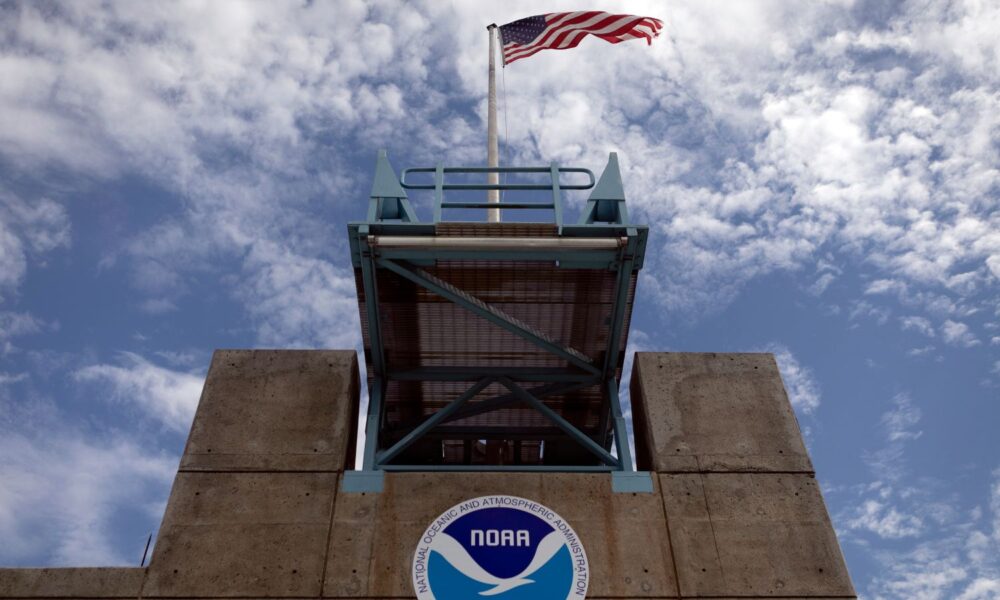The National Oceanographic and Atmospheric Administration (NOAA) is in the Trump administration’s crosshairs. Hundreds of scientists have been fired, and there have been proposals to close countless labs and facilities. And while there has been a groundswell of activism and media coverage pointing out the vital role that NOAA plays in keeping Americans safe and healthy, most of it focuses on the National Weather Service. While it’s absolutely true that cuts to the National Weather Service will make it harder to predict and monitor hurricanes and tornadoes, which will endanger countless lives and livelihoods, NOAA does so much more than this, and much of the vital services they provide aren’t getting enough attention. Here are ten lesser-known responsibilities of NOAA scientists.
1: Providing science-based fisheries management
NOAA makes sure that US fisheries are sustainably managed, keeping US fishermen (and women) employed and keeping seafood on our tables for generations to come.
Overfishing, the unsustainable practice of taking too many fish out of the ocean so that there are too few left to replace themselves, results in the total collapse of fisheries, and economic devastation for surrounding fishing communities. When combined with the other impacts of poorly managed fisheries, including bycatch (accidentally catching something swimming near what you were trying to catch) and habitat destruction caused by some fishing gears, it’s no surprise that organizations like the Environmental Defense Fund call overfishing “the most serious threat to our oceans.”
Science-based sustainable fisheries management helps prevent overfishing and minimize bycatch and habitat destruction caused by fisheries, and it’s the job of NOAA fisheries to do just that.
Notably, the NOAA-administered system of fisheries management gives local communities a seat at the table. Far from the conservative caricature of DC bureaucrats telling people how to live, the Fisheries Management Councils have local offices in fishing communities around the country, and give representatives from the fishing industry, as well as state governments, experts from academia, and environmental advocates, a seat at the table where important decisions are made. This is a model of science-based participatory management.
NOAA’s role also includes monitoring for Vibrio bacteria. If there is a Vibrio outbreak, you do NOT want to eat shellfish. And if no one is checking, you should probably assume that there is a Vibrio outbreak and not eat shellfish! NOAA checks.
NOAA also makes sure that seafood imported into the United States is what the labels say it is, making sure the food we eat is safe and healthy. “Seafood Fraud,” in which a lower-quality fish is falsely sold as a more expensive species of fish, is a major problem. If you’ve ever eaten escolar that was falsely sold as tuna, you almost certainly had an unpleasant rest of your evening. NOAA’s Seafood Import Monitoring Program helps makes sure this isn’t happening.
2: Protecting endangered species
NOAA is the US agency responsible for protecting endangered species found in US oceans (those living on land or rivers are covered by the US Fish and Wildlife Service). This includes research, creating and enacting species recovery plans, and public outreach.
NOAA also enforces the Marine Mammal Protection Act, the law established in response to “Save the Whales” activism. This includes coordinating the National Marine Mammal Stranding network and directly freeing entangled animals.
They also represent the US in international fisheries and conservation meetings- vital, because many of the species of conservation concern don’t stay within the political boundaries of human nations.
3: Monitoring ocean safety
NOAA’s National Ocean Service monitors all kinds of oceanographic and environmental conditions, including tides (and associated flood risk in coastal communities), levels of a variety of toxic contaminants that could pose a health risk to people who are eating seafood or even swimming, and harmful algal blooms like those that cause Red Tide. They also monitor ocean acidification, sea level rise, global CO2 levels, and sea surface temperature, all key impacts of climate change that need to be monitored.
All of this data, as well as countless other datasets and nautical charts and tools for safe navigation, are publicly available for free for anyone’s use, an incredible resource. Many of these datasets have been deleted or slated for deletion by the Trump administration despite the fact that taxpayer dollars paid for creating them, and continuing to operate them costs only a small hosting fee.
4: Protecting habitats and cultural sites
The National Marine Sanctuary system protects critical areas of marine biodiversity, as well as “submerged cultural heritage” (historically important shipwrecks,) throughout US waters by restricting destructive activities like industrial fishing or offshore oil and gas exploration. A robust system of marine protected areas is absolutely critical for keeping fisheries sustainable, protecting key habitats like coral reefs, and saving sea turtles and whales. (The Trump administration recently removed protections from the largest Sanctuary.)
5: Creating jobs and opportunities
The National SeaGrant College program, operated through NOAA, helps coastal communities in countless ways. By providing resources and expertise directly to local experts and local communities, the SeaGrant program has an absolutely enormous impact. The Trump administration targeted Maine’s as part of bullying the Governor of Maine over transgender student athletes. SeaGrant also administers the Knauss Fellowship, a highly competitive program which trains future federal scientists and legislative aides.
6: Cleaning up the ocean
NOAA removes marine debris from the ocean and stops it from entering the ocean in the first place. They also helps coordinate oil spill responses, and restore habitat damaged by oil spills. Sadly, the Trump administration’s offshore energy policies will make future oil spills far more likely.
7: Encouraging discovery
NOAA employs the only Federal researchers with a mission of pure exploration. They’ve made countless amazing discoveries while engaging millions of people, and thousands of classrooms, through their expert-narrated livestreams.
8: Promoting everyday engagement with science
Citizen science (increasingly called community science), in which non-scientist members of a community volunteer in support of research, is an important way to gather many types of vital scientific data. NOAA administers dozens of citizen science projects. Their efforts include the largest and oldest citizen science program in the world, the NOAA Cooperative Angler Shark Tagging Survey, in which anglers who catch sharks tag them, measure them, and release them.
9: Providing a high ROI
NOAA services investments have an absolutely massive economic impact in coastal communities around the world—and that’s not even counting how the free information and services they provide contribute to shipping, tourism, and construction sectors. One estimate says that every $1 invested in NOAA resulted in more than $2 in direct economic output.
10: Putting science into action from the seas to outer space
And so much more! NOAA also helps with supporting aquaculture small businesses, science education in classrooms and for the public, tracking and fighting against invasive species, restoring key marine and coastal habitats, archaeology, training astronauts, and countless other roles.
NOAA must be protected
Are you surprised that one little agency—one that costs way less than 1% of the total US government budget—does all this? Consider the following.
The United States has over 95,000 miles of shoreline, counting Alaska, Hawaii, and the US territories. And for over a century, the US Coast and Geodetic Survey, which later became NOAA, was the United States’ only scientific agency.
NOAA is one of the crown jewels of United States’ science, technology, and public safety apparatus, and must be protected from reckless, ignorant cuts.

